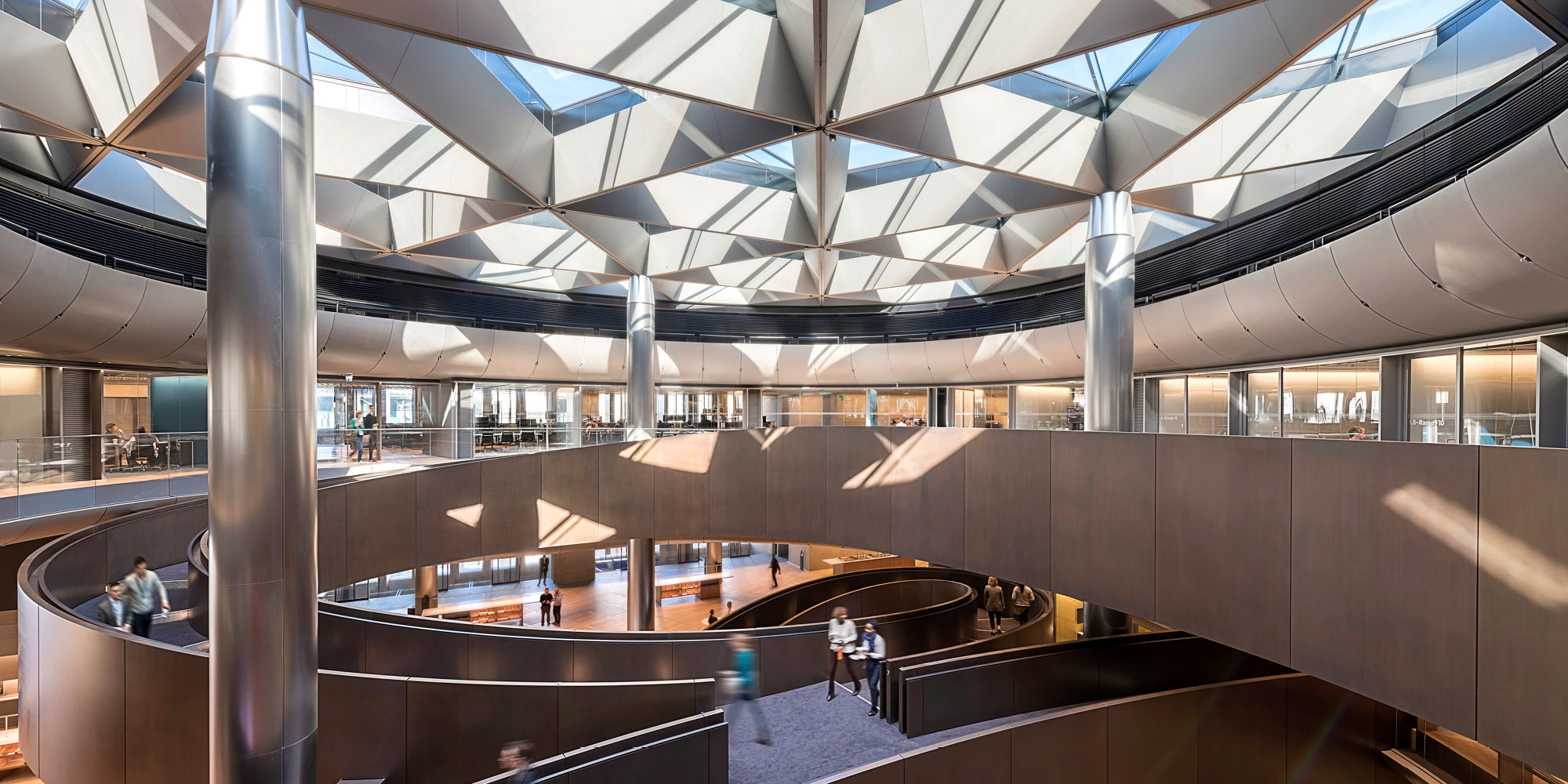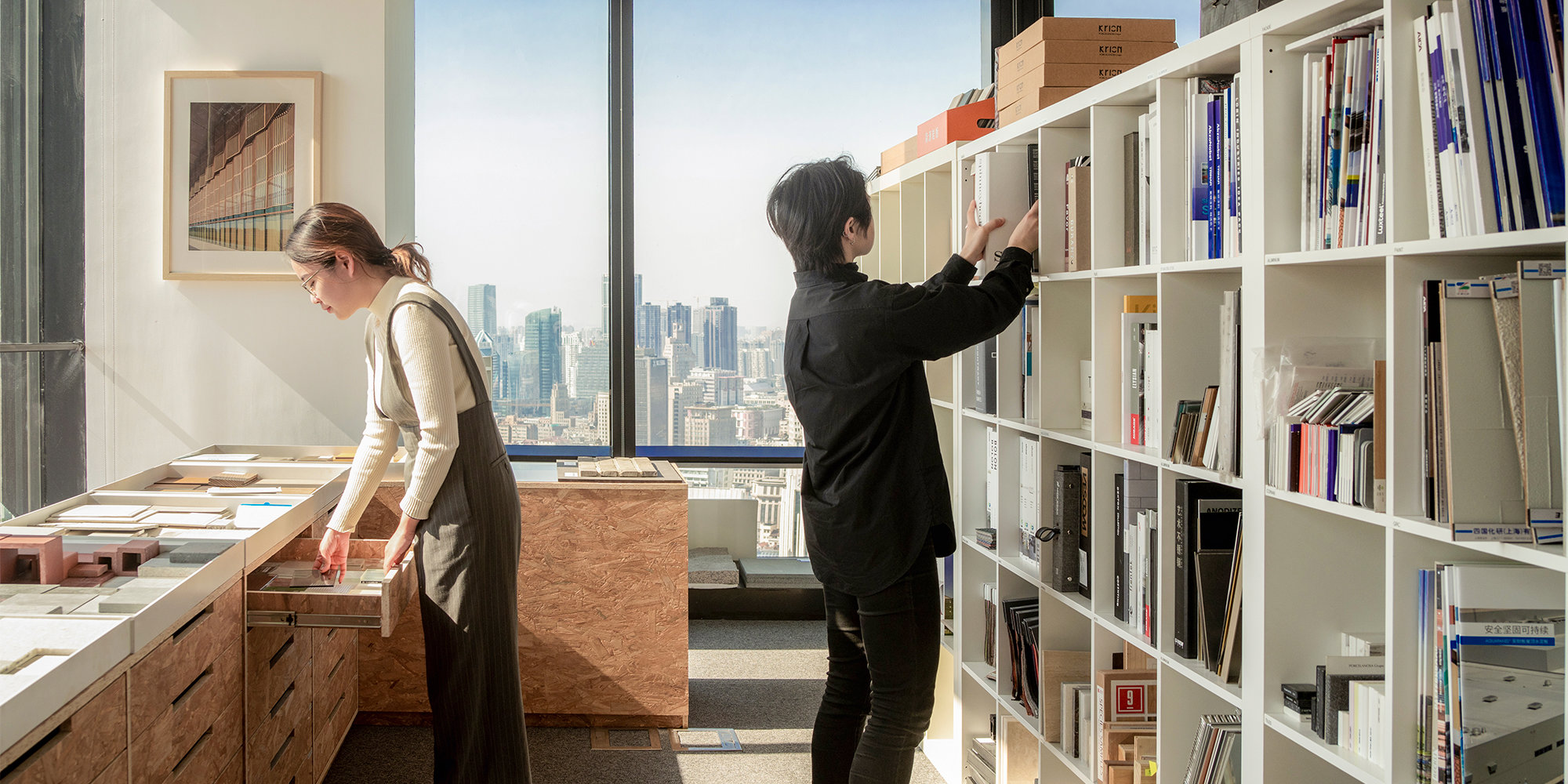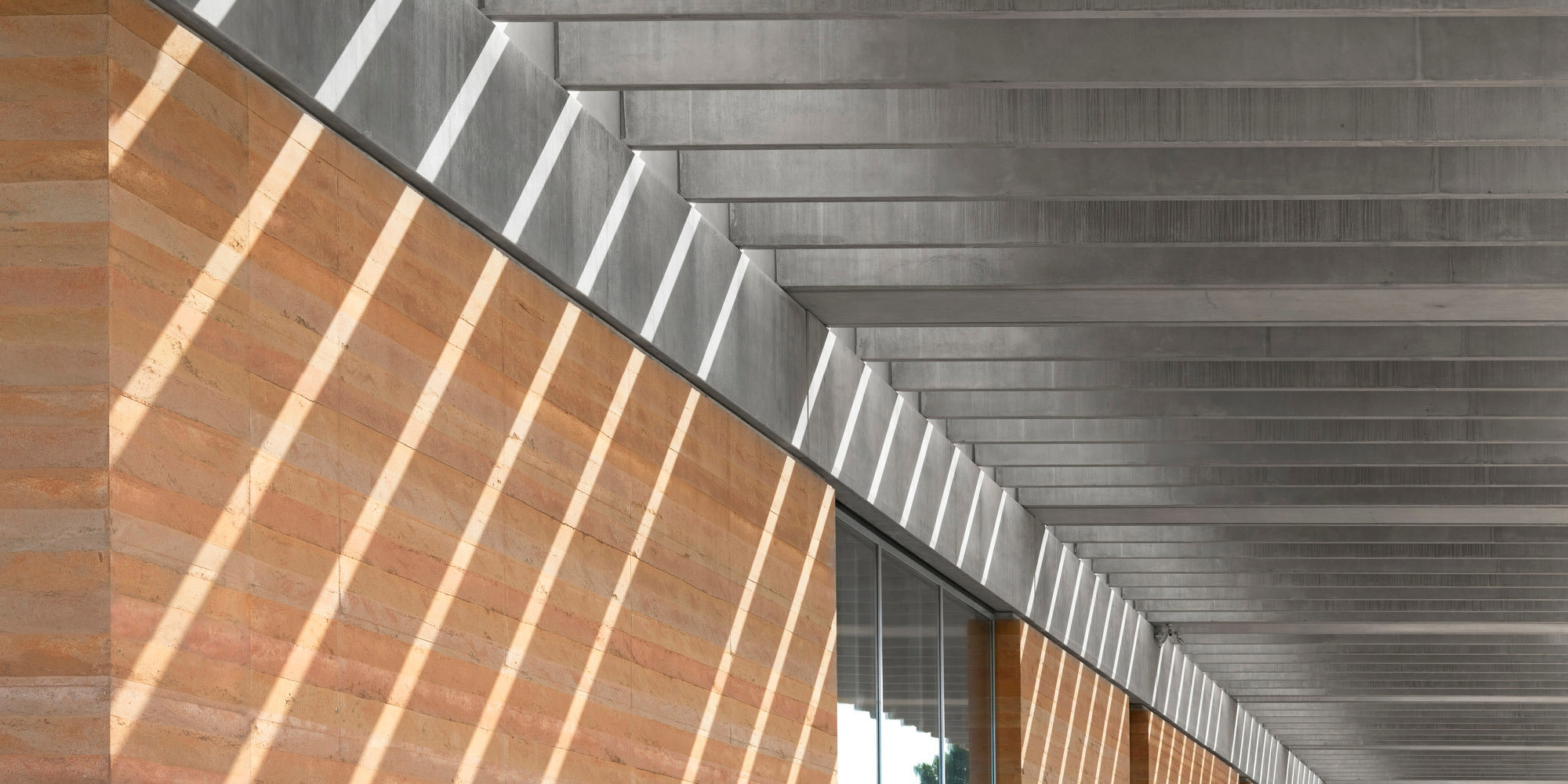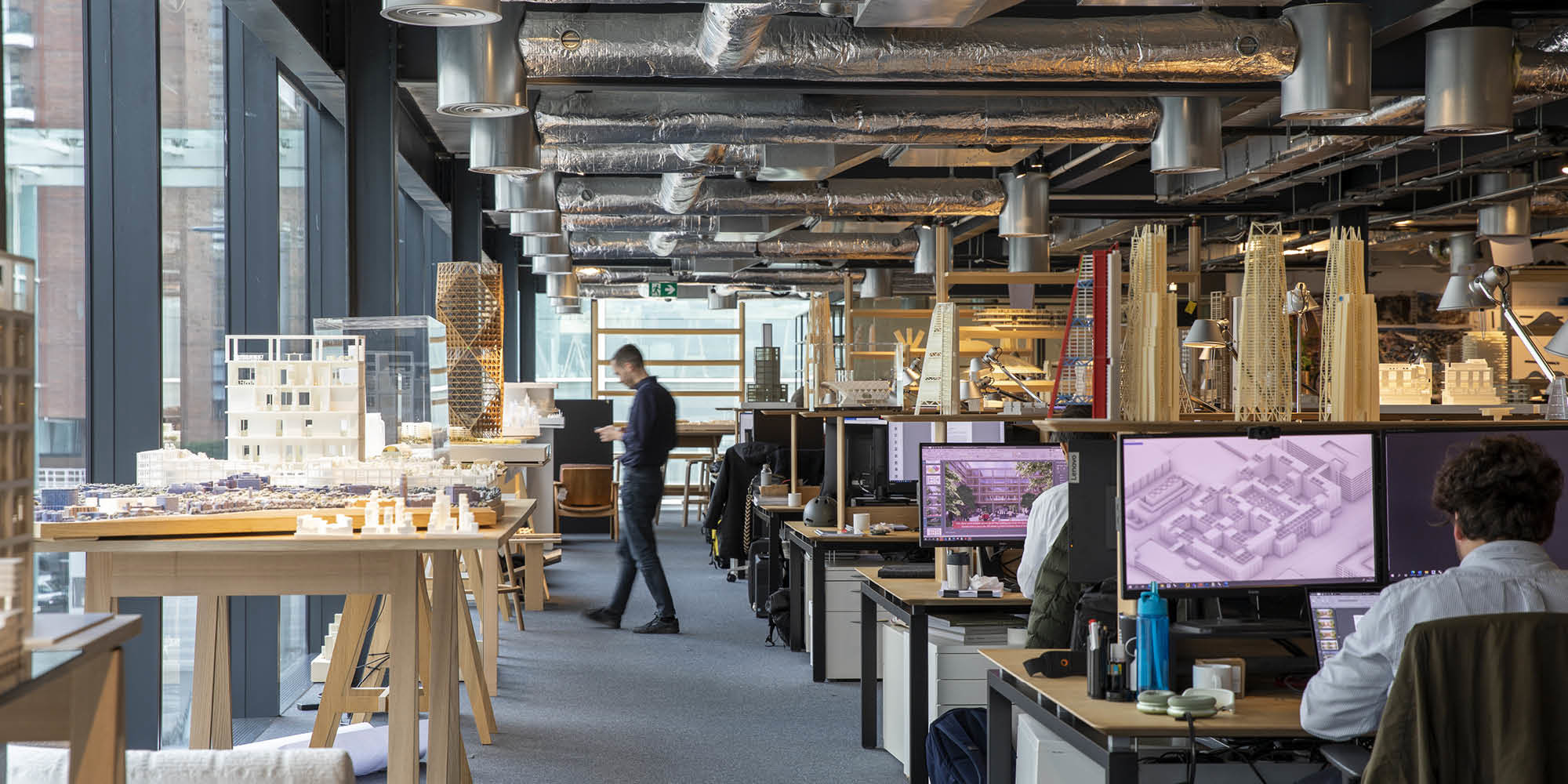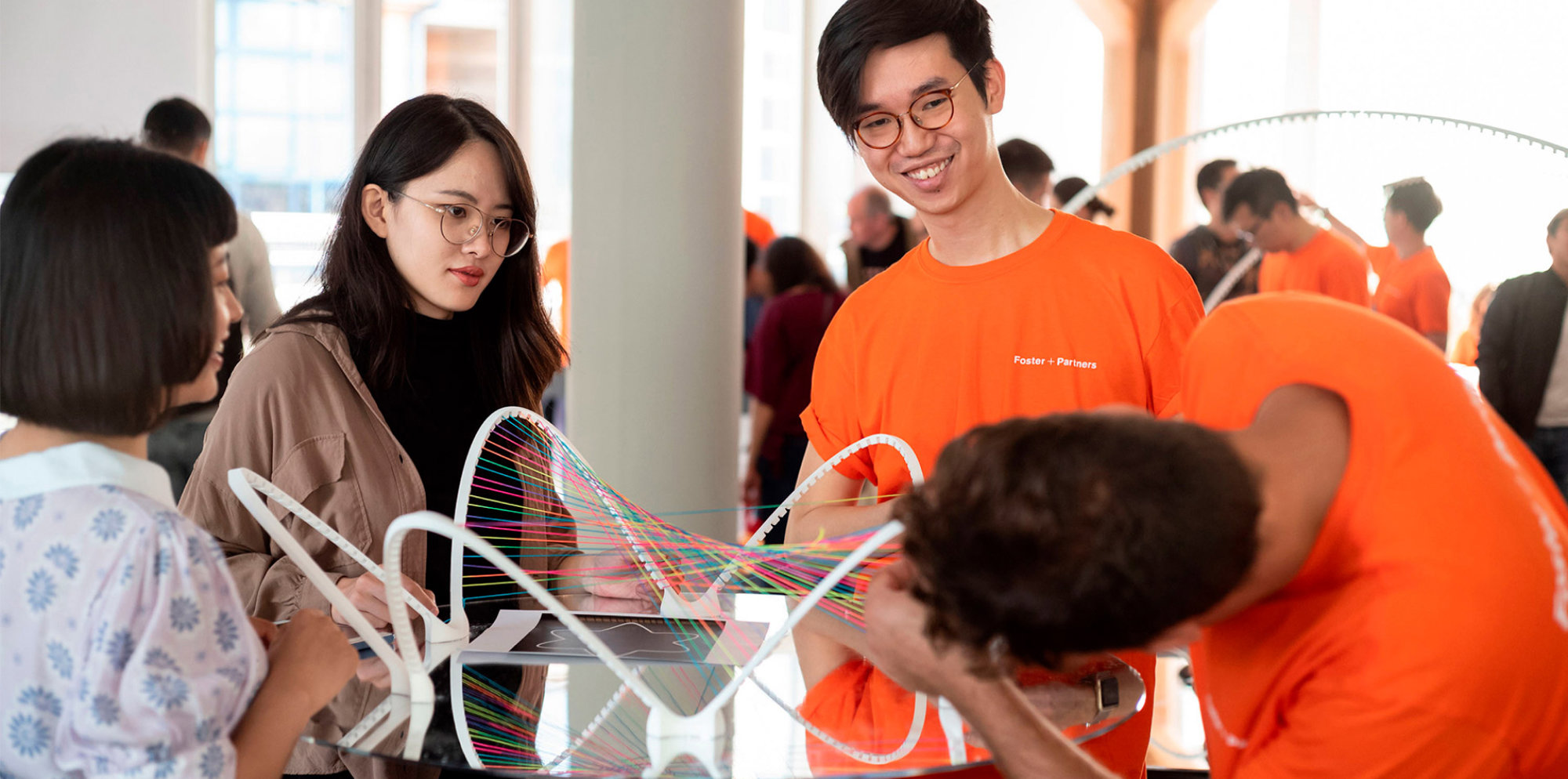Art and architecture have long been in conversation, with collaborations between their practitioners resulting in highly original and innovative work. Looking back on their collaborations both conceptual and realised, artist Jason Bruges, Founder of Jason Bruges Studio, and David Nelson, Head of Design at Foster + Partners, discuss the importance of establishing a shared design language, what art can bring to the built environment, and how nature and technology can be used to choreograph an experience.
13th August 2024
The Artist and the Architect: Jason Bruges in Conversation with David Nelson
David Nelson (DN) Jason, shall we begin with where we intersect? You trained as an architect and then worked at Foster + Partners, and then, after some time, moved on to form Jason Bruges Studio. You have since collaborated with Foster + Partners as the ‘artist’ instead of the ‘architect’. How does your architectural training carry through to your work today?
Jason Bruges (JB) Architecture is a great starting point, a fantastic schooling, for anything. It teaches you how to get stuff done. It’s not just about supplying an artistic concept and handing a drawing to someone else to figure out. If you can talk authoritatively about how you can do something, and you can communicate this – through writing, drawings, images, prototypes, contracts, financial reports, software, testing, research – then people will trust you and want to work with you.
Jason Bruges Studio is a multi-disciplinary art practice of twenty-five people, exploring the relationships between architecture, art, engineering, coding, computational design, visualisation, and more. Like Foster + Partners, we are constantly making. We design systems, we craft images, we develop prototypes to test what we want to do and to provide evidence that we can achieve what we propose. And we are responsible for the manufacture of the work. So even though we are separate from the architects, from a project management point of view, we work like architects because we can communicate consistently what we want to do and contractually deliver on that.
DN That’s very clever because the project manager can allocate you an area and then trust you enough to leave you to it. And, yes, this idea of making – of being able to use your hands to craft things – is vital. It’s such a dying art. For Foster + Partners prototyping has always been crucial because mock-ups at a 1:1 scale can give you extra information as you communicate and test your ideas. A prototype doesn’t imply that we are nervous or indecisive; it’s quite the opposite. There’s a real benefit in producing elements in advance. It helps the people who design it and the people who build it. It produces confidence. That was certainly the case for our work together in Hankook in Seoul.
Prototypes for Digital Phyllotaxy, designed for Hankook Tire’s headquarters in Pangyo, Seoul. © Jason Bruges Studio
Prototypes for Digital Phyllotaxy, designed for Hankook Tire’s headquarters in Pangyo, Seoul. © Jason Bruges Studio
Prototypes for Digital Phyllotaxy, designed for Hankook Tire’s headquarters in Pangyo, Seoul. © Jason Bruges Studio
JB Yes, with Hankook it was all about thinking about this journey through the building. My team and I were brought in to install something that could flow around the escalator in the atrium. The client wanted to create a transition that could gently break down and define the atrium’s large internal volume. So we began thinking about the idea of a gateway or a threshold. And that led us to consider things that we all go through that have an ‘underneath’, an ‘inside,’ and an ‘above’. Water, for example – you have an underwater, the split-level display, and then the view of the surface. Soon enough we reached trees and the sensations of being below, amongst, and above them.
Designed for Hankook Tire’s headquarters in Pangyo, Seoul, Digital Phyllotaxy (2020) is inspired by the vertical journey through the building and explores the idea of split-level experiences. © Giraffe Pictures courtesy of Jason Bruges Studio
16m in diameter, Digital Phyllotaxy uses a bespoke media assembly comprised of edge lit LED units and liquid crystal shutters. The layering of each component is choreographed to create delicate volumes of illumination and obscuration. A palette of inputs including sun paths, wind speeds and the movement of people passing by, trigger a generative atmosphere with the everchanging, arboreal crown. © Giraffe Pictures courtesy of Jason Bruges Studio
16m in diameter, Digital Phyllotaxy uses a bespoke media assembly comprised of edge lit LED units and liquid crystal shutters. The layering of each component is choreographed to create delicate volumes of illumination and obscuration. A palette of inputs including sun paths, wind speeds and the movement of people passing by, trigger a generative atmosphere with the everchanging, arboreal crown. © Giraffe Pictures courtesy of Jason Bruges Studio
16m in diameter, Digital Phyllotaxy uses a bespoke media assembly comprised of edge lit LED units and liquid crystal shutters. The layering of each component is choreographed to create delicate volumes of illumination and obscuration. A palette of inputs including sun paths, wind speeds and the movement of people passing by, trigger a generative atmosphere with the everchanging, arboreal crown. © Giraffe Pictures courtesy of Jason Bruges Studio
Digital Phyllotaxy derives its name from the arrangement of leaves on a stem. The artwork is a visual metaphor for a tree, which evokes a pseudo-random arrangement of leaves, twigs, and branches, that is carefully choreographed using light and shadow. That’s quite a conceptual description. How could we articulate the ‘dynamic volume’ that we were promising, and situate it in the context of the building? Working with the architects was key. When it became clear that we couldn’t attach the work as originally planned, we were able to adapt and ask: “What if this is a suspended structure, and does that affect anything architecturally, pragmatically, code-wise?” In the end, we formed attachment points in space based on the arrangement of the oculus that we were working with. It was a very architectural way of designing, as well as metaphorical.
DN Yes, the timing of an engagement in a collaboration is what determines where you might or might not be. And there is no room for ego, or the character of the ‘lone creator’ when everything has to be considered simultaneously. Architecture constantly interacts with and depends on a wide range of disciplines externally (cost consultants, clients, contractors) and internally (Foster + Partners has ecologists, mathematicians, engineers, and so on). And then, on top of all this, you bring artistic thoughts in! It’s a chaotic process and you have to enjoy the ‘chaos’, you have to let different people throw things across the table.
At the same time, however, there needs to be a direction underpinned by a shared language so that all these different ideas can eventually come together and make sense as a whole. That shared language is essential to delivery.
JB Absolutely. We need to know how our ideas can materialise through prototyping, testing, doing proof of concepts and how it will then fit into the built environment, and be formed by it. What I think is particular about my studio’s work (that is perhaps a little different from an industrial designer or a product designer who thinks in detail) is that we are constantly switching between the macro and the micro. Working in this way often means it is harder to pinpoint where the building ends and the art begins. The art is still its own endeavour, of course, but it is in very close dialogue with the architecture and its users.
DN Your work seems to enjoy operating in that space between the architectural and the artistic, never committing to one domain. The term ‘design’ might be more appropriate, but it is also too general. On the one hand, you are entirely capable of working with architects and understanding how your work can be integrated into a project. On the other, you can tap into something that might be implicit within that project in a way that only an artist – not an architect – can do. Where do you see your work departing from or extending the architectural?
JB I have always been interested in the idea that experiences in a space could be choreographed and animated, and how design could install this idea of everyday performance within the built environment. Throughout my training as an architect, I was always exploring performance… so there is a continuity there. The key difference is that as a practising artist today, my briefs tend to be about delivering an emotional experience rather than fulfilling a function. And I enjoy the freedom to experiment that comes with an emotional brief. However, we also use a language of architecture to bring that to light, to cite it. I get stuck when I don’t have something to respond to as I thrive on the conversation between the architecture and the intervention.
DN That makes me think of Dichroic Blossom, a work that you integrated into one of our residential projects in Beijing. It is an interactive feature wall that changes appearance according to different times of day and different seasons. Even the way that people move around the space and how many of them are present creates different projections.
Dichroic Blossom (2014), Media: Periscope LED light engines, bespoke mirror optics, bespoke dichroic crystals, IP camera, control system. Dimensions: 14.25m x 10m x 0.30m. © James Medcraft courtesy of Jason Bruges Studio
JB Yes, Dichroic Blossom was about expressing the poetics of the natural world through a technical lens. For this project, my team and I developed a mixed-media digital artwork that is our interpretation of the Chinese Plum Blossom. The blossom, known as the ‘Meihui,’ is one of the most beloved flowers in China and has been depicted in Chinese art and poetry for centuries. Artists have been doing this for a long time, making impressions of the natural world. The question for us was how to make an impression of ‘Meihui’ that was evocative of the tree throughout its seasons, but perhaps more abstract and technical in its execution and knitted into the built environment.
So, rather than petals, we used light. For me, controlled, animated, choreographed light is a big part of the palette of much of my work. We are turning lights on and off with an extremely high level of coordination. We link that with movement – I often use the term ‘luminokinetic’ – and how movement needs to be carefully researched and processed so that a collaborative performance becomes possible. And so that requires software development, which then interacts with custom-made hardware. It's like having an amazing theatre provided for you, and the task is to put on a play where you need to design the show and all its underlying mechanics to ultimately deliver a sense of magic and wonder. And that feeds into wellbeing, which is about making an experience of a space relaxing and rewarding for people.
Clusters of periscope LED light engines refract and reflect creating an amplifying effect via a network of dichroic wall sculptures. The pattern progresses up the wall dependent on an algorithm which considers the number of people standing next to the wall and their proximity, dwell time and grouping. © James Medcraft courtesy of Jason Bruges Studio
Clusters of periscope LED light engines refract and reflect creating an amplifying effect via a network of dichroic wall sculptures. The pattern progresses up the wall dependent on an algorithm which considers the number of people standing next to the wall and their proximity, dwell time and grouping. © James Medcraft courtesy of Jason Bruges Studio
Clusters of periscope LED light engines refract and reflect creating an amplifying effect via a network of dichroic wall sculptures. The pattern progresses up the wall dependent on an algorithm which considers the number of people standing next to the wall and their proximity, dwell time and grouping. © James Medcraft courtesy of Jason Bruges Studio
DN ‘Experience’ can be easily forgotten in the currency of architectural discourse. Increasingly, though, this idea of experience (which feeds into wellbeing) is considered at a design stage. Spaces aren’t just qualitatively ‘good’ or ‘bad’; we can now quantify them in terms of stress indicators, navigability, air quality and airflow, acoustic quality, UV and infrared levels, biodiversity score, and so on. I think that engaging with these more phenomenological aspects of a building – measurable or otherwise – is where architecture can expand. That is why it is always fantastic to work with artists because art can shake architectural assumptions and hierarchies by foregrounding experience and emotion.
It is also very interesting that your ideas of wellbeing and magic and wonder are often inspired by the natural world – tree canopies, blossom, water, light. I mean, being under a tree in the sunlight is one of the best places to be! It calms the nervous system, it engages the senses, it’s a total bodily experience. As Foster + Partners encounters and works with some of the most innovative technologies in the world, nature is constantly revealing itself to us. The internal structure of some race car components can be uncannily close to the structure of a bird’s wing; the geometry of sand dunes can be coded and modelled to think about facade patterning as well as surface formation on extra-terrestrial planets. Technology and the natural world are always in dialogue. We have to tune in.
JB The natural world is a huge source of inspiration for all those reasons. I think it also feeds into my ideas about performance. Nature teaches us that nothing is static; there is a rhythm, an evolution, a narrative, a cycle. Perhaps that is why I am drawn to transitional spaces where people are moving through an environment – maybe staying, maybe not. And there is an opportunity to orchestrate something dynamic within that ongoing flux.
In 2009, Jason Bruges Studio were approached by Foster + Partners and Buro Happold joint partnership to develop specialist lighting for four Haramain High Speed Rail Stations, in Saudi Arabia. Jason Bruges studio were originally appointed to provide concept development, scheme design, technical design and construction drawings. In 2013, they were re-appointed to oversee the prototyping and testing phases of the project. © Nigel Young / Foster + Partners
The resulting artwork has a majestic yet ethereal quality. It sits harmoniously within the atmospheric architectural setting softening the dramatic vaulted roof with dancing rhythms of natural light during the day and artificial light when it is dark. © Nigel Young / Foster + Partners
The resulting artwork has a majestic yet ethereal quality. It sits harmoniously within the atmospheric architectural setting softening the dramatic vaulted roof with dancing rhythms of natural light during the day and artificial light when it is dark. © Nigel Young / Foster + Partners
Our commission for the Haramain High Speed Rail stations across Saudi Arabia was all about arrival and departure and responding artistically to those concepts. A train station is a great opportunity to reconsider a journey through space as a series of experiences happening in multiple directions. In the cross-media, cross-disciplinary way that we all work, my team thought about these concepts while generating a model that could function architecturally and technically. We imagined a series of chandeliers which scattered sunlight and artificial light across the concourse. To do this, we needed to know about the fenestration and holes in the roof so we knew where light gets in, which required working closely with the architects. Initially, our design used solid prisms, but we soon realised they would be too heavy to hang. So we custom-built prismatic cells (which resemble hollow jewels) that could be suspended in a toroidal arrangement and scatter light in ephemeral and delicate patterns.
Testing the lighting effect with a 1:1 mockup in LH2 Testing Facility, London. © Jason Bruges Studio
Testing the lighting effect with a 1:1 mockup in LH2 Testing Facility, London. © Jason Bruges Studio
Testing the lighting effect with a 1:1 mockup in LH2 Testing Facility, London. © Jason Bruges Studio
Testing the lighting effect with a 1:1 mockup in LH2 Testing Facility, London. © Jason Bruges Studio
Testing the lighting effect with a 1:1 mockup in LH2 Testing Facility, London. © Jason Bruges Studio
I remember thinking at the time: how on earth do you verify this? So we spoke to lighting specialists, Bartenbach, in Switzerland, and we ended up conducting tests with in the LH2 Testing Facility in London. It is one of the only places that has room to rig a lamp powerful enough to mimic the sun. We controlled daylight conditions so that we could see exactly how the patterns would change throughout day and night. We used this information to explore different optical qualities of the faceted glass to ensure the correct levels of brightness. Again, it was about thinking deeply about a philosophy of light and then expressing this with technical fluency. I don't think many artists prototype their work at a 1:1 scale like that, just to see how a shadow will land. I think that is pretty special.
DN Yes, your work is never one note: it is designed to change and to be responsive and be something to respond to. What other disciplines have helped you to think beyond this ‘static’ image of a building? Why do you push your work to perform in the way that you do?
JB Other industries think about ‘experience’ much more, and at a multisensory level. People who design a car are asking: how does the door closing sound? How does the engine sound? How should it light up when you get in? A car has a whole sound signature and soundscape, as well as a visual and technical language. And I find that useful in my own work, to think in that way. To always be asking: what is the atmosphere here?
Storyboarding, which comes from the film industry, is also part of my process. A storyboard is a visual and didactic and temporal tool, and it is a way to make sure you’re reaching for the right notes, the right feelings. When we were recently commissioned to do a water-based installation for a museum, we mapped it out at ten second intervals. Each frame contributed to a non-linear story arc that was always changing. It looked effortless, but it was highly sequenced and controlled. Often, people will look at what we do and not know what has contributed to the final piece. Much of that processing is deliberately hidden.
DN Yes, there is a dialectic of effort and ease. Huge amounts of collaboration go into a project and the result – given that it’s all integrated by the end – can often hide or obscure this hard work.
JB Paradoxically, the better integrated the thinking and the final design, the more it conceals its own working. And you’re right: without obvious information, it is hard to comprehend the amount of people it takes to make things happen. However, we do also find that clients do like to go on that journey. They like seeing the workshop and what you’ve been testing, the tactility of things, and what you have made that has been successful and unsuccessful in order to get where you are. For me, that’s always been very rewarding. In our world, where there are a lot of technologies and processes, sometimes the ‘behind the scenes’ view can be as successful as the finished work.
Foster + Partners modelmaking on Stewarts Road, London. © Nigel Young / Foster + Partners
Prototype review in the Material Research Centre within Foster + Partners Riverside Studio, London. © Aaron Hargreaves / Foster + Partners
DN It is hard to give proper credit to the scope of collaboration that happens in architecture – especially when architects tend to be the headline acts of building stories. The film industry, with its ‘behind the scenes’ that you just mentioned, is much better at it. The list of credits at the end recognises the film as being a collaborative endeavour. Architecture is not told that way, but I think it needs to be. I wonder, to return to your field, what do you think it is that keeps a collaboration going? How do you sustain it?
JB One thing that I've always enjoyed and that underpins everything I do is curiosity – a thirst for testing ideas and exploring new ways to communicate across disciplines. Each conversation is a little different. If we are working with roofs or canopies, we might be blocking sunlight or we might be redirecting sunlight. We might be creating shadows. In other projects, we might be developing digital composites or robotics. We are also looking at neural networks that control systems, and artificial intelligence that can help us to develop artworks that appears to evolve organically. And my studio can do this because, like Foster + Partners, we have all the relevant expertise in-house. I suppose, within any relationship, conversation naturally ebbs and flows. You have to allow breathing room and you have to trust that disciplinary gaps can and will be overcome.
DN I also enjoy the ebb and flow. Shared curiosity is good, but soon enough you have to draw it up properly, get granular, test your prototype. Then you can have a dialogue about it. And this all takes time. We don’t meet clients every day; we might leave three or four weeks between meetings so that we have time to properly explore all possibilities. I think the big danger at the moment is that timescales are being dramatically cut across industries. And this is set against, arguably, an increasingly difficult and complex environment to build in. As the design process is being put under increased pressure, having a diversity of perspectives and skills at the table allows us to continue to deliver innovative projects. It is also so exciting.
JB Yes, it all comes back to having a versatile team who can navigate changes in pace and direction. You need people who can do the sprint finish and people who can carry out longer periods of deep and methodical work, meaning that the quality of thinking and range of experience within a design team is vital. An idea that might appear to be last-minute is often the formulation of thousands of hours of research and consideration. We need to remember this, especially in an age of immediacy, where anyone with a phone can make and publish a song, a film, a poem, in ten minutes. But it takes real skill and expertise to be able to deliver work time and time again, and that is a practice that must be developed and matured. However, I am careful not to be too calcified by previous projects. Curiosity and creative freedom are also key ingredients – they just need to be backed up with a confidence in delivery that comes with experience.
Dynamic Tread (2020), installed in Hankook Tire's headquarters in Pangyo, Seoul. Made from a large-scale matrix of cylindrical glass nodes, with embedded LED arrays, the artwork analyses live weather data and uses a generative algorithm to inform complex choreographies of light. In a series of keyframes, radial monochromatic patterns evolve and represent the changing tire treads as weather conditions shift outside. © Giraffe Pictures courtesy of Jason Bruges Studio.
Author
Jason Bruges and David Nelson
Author Bio
Jason Bruges is a multidisciplinary artist and designer, based in London. Internationally renowned as a pioneer of the hybrid space between art, architecture, and technology he creates site-specific, ‘sculptural barometers’ that tap into the emotional tapestry of a community or place by translating live feedback into living, breathing, spatial interventions.
David Nelson is one of the Heads of Design at Foster + Partners. David joined the practice in 1976, moving to Hong Kong in 1983 to work on the Hongkong and Shanghai Bank. He returned to London in 1986 and since has led projects across all scales – from furniture to infrastructure. He now shares overall design responsibility at the practice. David loves racing cars and new technologies and likes to walk the length and breadth of cities, particularly new destinations.
Editors
Tom Wright and Clare St George
